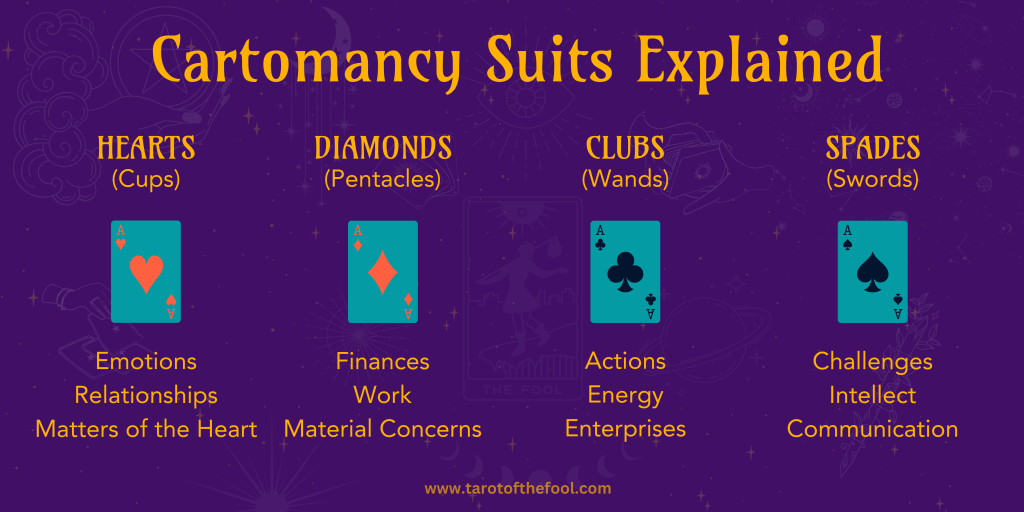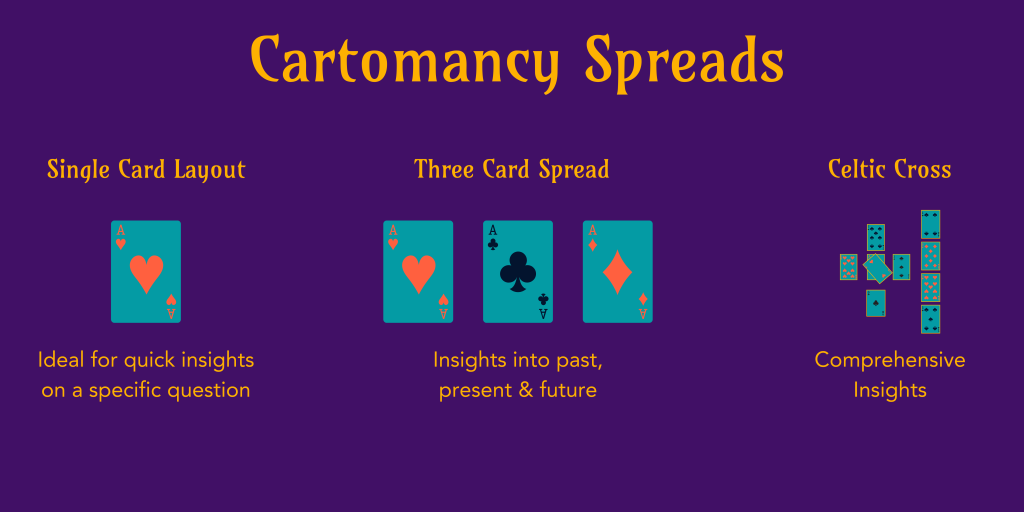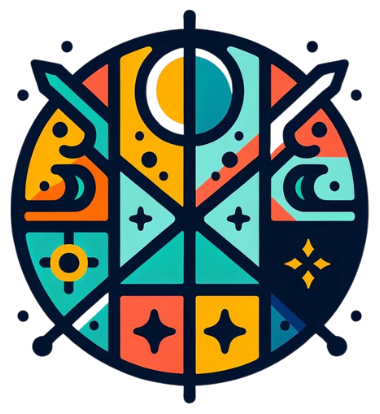Interested in reading tarot but don’t have your own deck? Look no further than your games cupboard and grab any old deck of playing cards to use for your reading! Using a deck of cards for your tarot reading is called cartomancy and dates back centuries.
Cartomancy is a practice nestled within the broader world of divination, where a standard deck of playing cards serves as the medium to uncover insights and foresee events.
This form of fortune-telling dates back to the 14th century following the arrival of playing cards in Europe. As a divination tool, cartomancy is revered for its accessibility and the connection it builds between the reader and the charm of everyday playing cards.
The art of cartomancy is grounded in the meanings attributed to each of the 52 cards, which are often closely intertwined with the reader’s intuition.
Understanding the symbolism behind the hearts, spades, clubs, and diamonds and the significance of the card numbers is fundamental for your reading. As you venture into the practice, you will discover various cartomancy spreads and techniques that can be tailored to specific questions and areas of concern.
Key Takeaways
- Cartomancy uses a standard 52-card deck of playing cards to offer insight and predict outcomes.
- Mastery involves learning card meanings and the various spreads.
- The practice connects personal intuition with the symbolism of the cards.
History of Cartomancy
As you explore cartomancy, you’ll discover it’s a fascinating form of divination that stems from the use of playing cards, with roots tracing back hundreds of years.
Early Origins
Playing cards first entered European culture in the 14th century, leading to the initial forms of cartomancy.
At this time, cards were often hand-painted and used by the upper class for gaming and, eventually, for divination.
The ability of cards to hold symbolic meaning made them perfect tools for divination practices, contributing to their spread across European courts.
European Courts and Evolution
By the 18th century, cartomancy had become increasingly popular. It reached further social circles and even the public marketplace.
This period saw the standardization of card meanings and interpretations, which expanded the accessibility and consistency of card readings. The practice evolved uniquely in different European courts, reflecting local cultures and symbolism in the various decks used for divination.
Getting Started with Cartomancy
Embarking on the journey of Cartomancy is like unlocking a new realm of understanding through the use of an ordinary playing card deck. It guides you to interpret patterns and insights that relate to various aspects of life.
Basics of Cartomancy
Cartomancy utilizes a 52-card deck. Unlike Tarot, which includes the Major Arcana and Minor Arcana, Cartomancy focuses solely on the traditional suits found in a regular playing card deck.
As a beginner, it’s essential to start with the foundational meanings of the cards, where each number and face card holds unique significance.
Choosing Your Deck
Opt for a specific deck that appeals to you. While some practitioners may suggest a dedicated cartomancy deck, a standard deck of playing cards is perfectly suitable.
Ensure your deck is complete, with all the cards present, to maintain the integrity of your readings.
The Significance of Each Suit
The suits in Cartomancy symbolize different aspects of life:
- Hearts represent emotions, relationships, and matters of the heart.
- Diamonds highlight financial aspects, work, and material concerns.
- Clubs indicate actions, energy, and enterprise.
- Spades are reflective of challenges, intellect, and communication.
Remember, the symbolism in Cartomancy is intricate, and each card’s meaning can shift in the context of a reading. Here, the suit gives you an overarching framework from which to build your interpretations.

Card Meanings and Interpretations
In cartomancy, each card holds a specific meaning that can illuminate aspects of your life and predict future events. The intricacies of the cards including court cards like Kings, Queens, and Jacks, each tell a different story in your reading.
Insights from the Minor Arcana
The Minor Arcana resembles a traditional deck of playing cards but includes tarot’s unique symbolisms. Divided into four suits – Cups, Pentacles, Swords, and Wands – each comprised of 13 cards, they reflect the day-to-day activities in your life.
- Cups: Emotions and relationships
- Pentacles: Finances and material aspects
- Swords: Intellect and conflict
- Wands: Creativity and action
Significance of Court Cards
The court cards, including Kings, Queens, Knights, and Pages, often represent actual people in your life. For example, the King of Hearts could be interpreted as an influential and emotional masculine energy in your life, while the Queen of Spades represents mental clarity and a mastery over logic and strategic thinking or suggest a sharp-witted, perceptive individual. Their depictions can vary based on the context of the other cards.
Interpreting the Aces
The Aces in cartomancy signal new beginnings. Whether it’s the Ace of Hearts indicating new relationships or the Ace of Clubs suggesting new endeavors, the Aces are powerful cards that hint at fresh starts and opportunities.
Interpreting Jokers
Jokers are not typically part of tarot decks, but when used in card readings, they can signify surprises or unpredictable events. While some traditions may attribute specific meanings to Jokers, their interpretation can often depend on the reader’s intuition and the surrounding cards.
Cartomancy Spreads and Techniques
In cartomancy, the spread you choose and the techniques you employ can significantly influence the clarity and depth of your reading. The following will guide you through the foundational layouts, methods of drawing cards, and essential reading techniques to enrich your cartomancy practice.
Basic Cartomancy Layouts

- Single Card Draw: Ideal for quick insights, you draw a single card to answer a specific question. The simplicity of this layout makes it a common choice for both beginners and seasoned cartomancy readers.
- Three-Card Spread: Here, you pull three cards that represent past, present, and future. This layout provides a basic understanding of how a situation has developed and where it is headed.
- Celtic Cross: This ten-card spread offers a comprehensive view of the querent’s situation and is often used for complex queries that require detailed interpretation.
Card Draw Methods
Shuffling Technique: Before drawing cards, you should shuffle the deck while focusing on your question to ensure a random and unbiased selection. Some cartomancy readers prefer overhand shuffling, while others might use the riffle shuffle.
- Card Selection: You may draw cards from the top of the deck or spread them out and choose whichever calls to you. Trusting your intuition during card selection is crucial for an authentic cartomancy reading.
Reading Techniques and Tips
Connecting the Cards: When interpreting the cards, look for themes or patterns that emerge. Are there multiple cards from the same suit or with similar imagery? These connections can offer deeper insights into your situation.
- Intuition vs. Established Meanings: Balancing traditional card interpretations with your intuition is key. Start by understanding the conventional meanings but also attune to your inner voice to decipher unique messages.
- Question Phrasing: Formulate your questions clearly. Ambiguous questions often lead to confusing readings, so strive for specificity to obtain more precise guidance from your cards. I often find my readings are more accurate when I write my question out before I start to make sure it’s clear.
In summary, mastering the art of cartomancy involves familiarity with various spreads and drawing techniques and honing your interpretative abilities. With practice, these tools will enhance your ability to offer insightful readings.
Practical Cartomancy
Cartomancy can be a useful tool for seeking guidance on everyday issues and personal matters. It offers clear and straightforward insights that can help with decision-making.
Everyday Questions and Guidance
For those times when you need a quick answer to a specific question, cartomancy can be a practical method. Whether you’re contemplating a career move or need insight into a financial decision, drawing a card can provide a nudge in the right direction.
For example, drawing the Ace of Hearts might signal that it’s a favourable time for new beginnings, suggesting good luck when venturing into uncharted territories.
Personal and Romantic Insights
In matters of the heart, cartomancy can deliver valuable insights into love affairs and personal relationships. A new relationship may be forecasted by the appearance of the 2 of Hearts, representing good fortune in love and relationships.
If you’re seeking clarity on the state of a romantic relationship, the cards can often reflect the energy surrounding it. Encountering the 6 of Hearts could indicate a surprise twist in your love life, potentially a new love interest or a deepening of a current bond.
When approaching personal experience with cartomancy, it’s important to be open and receptive to the messages the cards offer. Let the cards speak to the nuances of your relationships and provide the guidance you need for personal and romantic fulfillment.
Spirituality and Cartomancy
Cartomancy offers a unique lens through which you may gain spiritual insights and understand the potential influence celestial events have on your life.
Spiritual Insights
When engaging with cartomancy, you access a form of spiritual guidance that can reveal good news about your path. The cards in a cartomancy spread align with various aspects of your situation, providing a sense of reassurance when you draw a good sign.
Symbols depicted on the cards often resonate deeply with your subconscious, crafting a personal narrative that shines a light on your innermost thoughts and feelings.
The Influence of Celestial Events
During the new moon, it’s believed that pulling cards can help you set intentions and initiate new beginnings with confidence. Contrastingly, readings conducted during a full moon reflect a time of culmination and clarity, helping you understand the results of past actions and guiding you toward closure or celebration.
Cartomancy in Modern Times
Cartomancy, the art of divination through playing cards, has adapted to digitalization and contemporary values. Today, you’ll find that this ancient practice has gained a new look and offers easier access, ensuring that anyone looking for guidance, preparing for life changes, or pondering fresh starts can benefit from its insights.
Yes, it’s easy to find someone online to use cartomancy and provide you with a reading, I encourage you to learn the practice yourself and place the power of interpretation and action in your own hands!
Beyond the Cards
In exploring the realm of cartomancy, you’ll find that its applications and influences extend well beyond the playing cards traditionally used. Cartomancy borrows elements from various cultures and mystical traditions, and its methods and symbolism have paved the way for a diverse range of practices.
Tarot and Oracle Decks
Tarot cards are a specific type of deck used for cartomancy, originally stemming from card games dating back to the 15th-century.
A standard tarot deck contains 78 cards which include a unique set termed the Major Arcana which is not found in a traditional deck of cards. These 22 cards represent life’s karmic and spiritual lessons.
The remaining 56 cards, known as the Minor Arcana, reflect the trials and tribulations that you experience daily. Within the Minor Arcana, you’ll find 16 Court Cards representing 16 different personality characteristics we may choose to express at any given time.
Oracle decks, on the other hand, are more free-form and do not have a set structure like tarot decks. An oracle deck can contain any number of cards with a variety of themes, offering a more intuitive and personal approach to cartomancy.
These decks can be tailored to include references to mythology, specific spiritual paths, or thematic imagery.
Cultural Impact and Adaptations
Cartomancy has been significantly shaped by its cultural context. The Golden Dawn, an occult society from the late 19th and early 20th centuries, played a considerable role in the development of modern tarot readings.
They introduced the idea that the cards correspond to kabbalistic elements, astrology, and other esoteric systems which have influenced how readings are interpreted.
Over time, adaptations have emerged, assigning new roles and interpretations to different cards. For instance, the Joker card, often included in modern playing card decks, has sometimes been equated to the Fool card of the tarot, representing potential and new beginnings.
Trump cards in tarot, which include the Major Arcana, carry significant weight in readings, revealing major influences and overarching themes in your life.
Cartomancy has been adapted into various card games as well, moving from mystical practice to leisure activity.
These games, while primarily for entertainment, have sometimes retained aspects of cartomancy, hinting at the symbolic importance of cards across different cultures and contexts.
Even beyond the realm of divination, the symbolism of cartomancy is embedded in the fabric of cultural practices around the world.
Conclusion
Cartomancy is a divination tool with a tradition reaching deep into history. For centuries, individuals have turned to the mystical allure of playing cards to seek spiritual guidance and contemplate life’s complexities.
When you embark on the journey of understanding cartomancy, you are engaging with a practice that emphasizes introspection and personal interpretation.
Key elements of cartomancy include:
- A standard deck of 52 cards, each with its symbolism and meaning.
- The understanding that cartomancy is less about predicting the future and more about offering insights.
- Realizing that the practice can act as a mirror, reflecting your subconscious thoughts and feelings.
In embracing cartomancy, remember:
- Your intuition is crucial; trust it as you interpret the cards.
- Patterns and card combinations offer nuanced perspectives.
- Cartomancy is a personal experience; your insights may differ from those of others.
Through the act of card reading, you harness a method of grappling with life’s questions. While cartomancy can’t provide definitive answers, it offers a unique avenue for reflection—providing a framework for thinking about problems and decisions from different angles.
Whether you seek self-discovery or perspective on specific situations, the cards are a companion on your journey toward clarity.


No responses yet